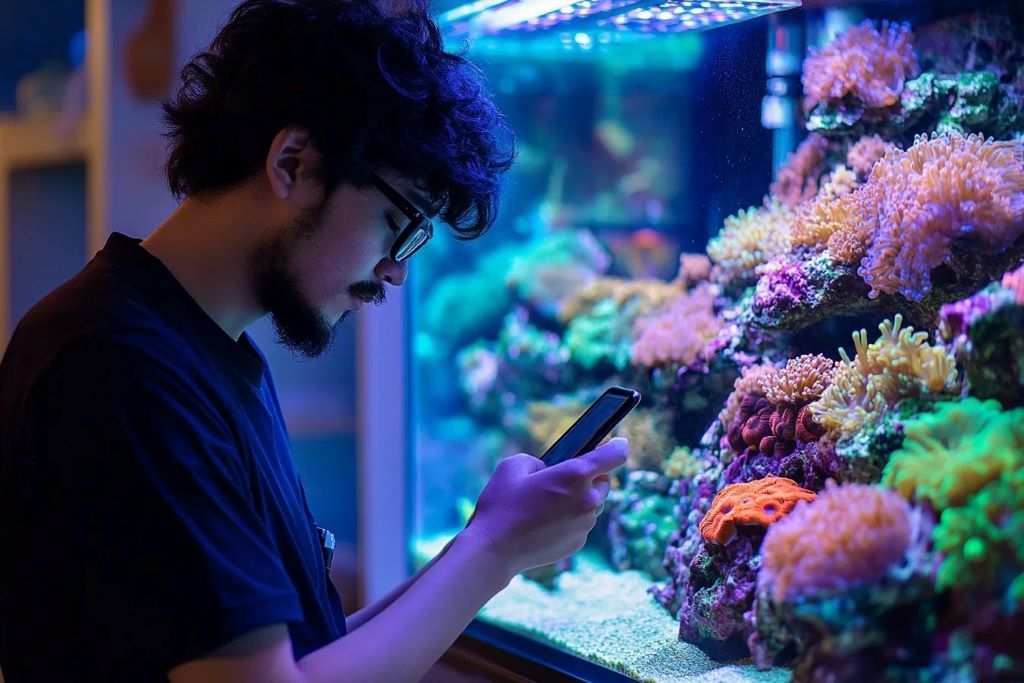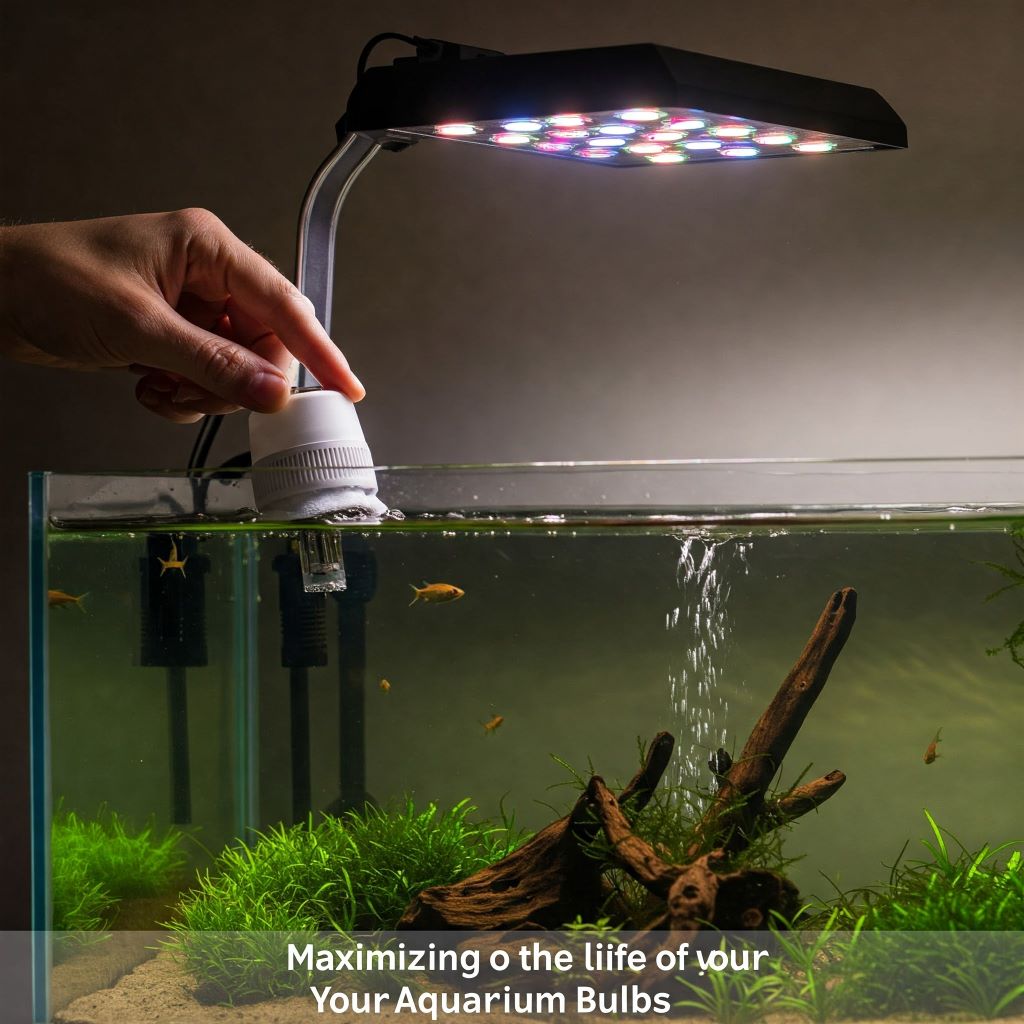Reef tanks are mesmerizing worlds in miniature, vibrant ecosystems teeming with colorful fish, corals, and invertebrates. But maintaining the delicate balance of this underwater paradise requires diligence, cleaning aquarium light fixtures, and the right equipment. One increasingly popular tool in the reef keeper’s arsenal is the algae scrubber. This natural filtration method harnesses the power of algae to purify water and create a thriving environment for your marine life.
A proper dimming schedule for your aquarium LED lights can help control algae growth by limiting the amount of light that reaches the algae. This article will discuss the importance of an aquarium LED dimming schedule for algae control, the benefits, how to set up a schedule, and answer frequently asked questions.
The Importance of an Aquarium LED Dimming Schedule for Algae Control
Algae, like plants, need light to grow. In an aquarium, excessive light can lead to an overgrowth of algae, which can be detrimental to the overall health of the aquarium. Algae can consume nutrients that are essential for plant growth, reduce oxygen levels in the water, and block light from reaching plants, hindering their growth.
An aquarium LED dimming schedule helps control algae growth by regulating the amount of light that enters the aquarium. By reducing the light intensity and duration, you can limit the algae’s growth rate, preventing it from taking over the aquarium.
Benefits of an Aquarium LED Dimming Schedule
An aquarium LED dimming schedule offers several benefits, including:
- Algae control: By limiting the amount of light, you can effectively control algae growth and prevent it from becoming a nuisance.
- Improved plant health: A proper dimming schedule ensures that plants receive adequate light without promoting excessive algae growth.
- Energy savings: Dimming the lights reduces energy consumption, saving you money on electricity bills.
- Extended lifespan of LED lights: Reducing the intensity and duration of light can help extend the lifespan of your LED lights.
- Natural day/night cycle: A dimming schedule mimics the natural day/night cycle, which can benefit the overall health and well-being of your fish and other aquatic life.
How to Set Up an Aquarium LED Dimming Schedule

Setting up an aquarium LED dimming schedule involves determining the right light intensity and duration for your specific aquarium setup. Here’s a step-by-step guide to help you get started:
-
Determine the Right Light Intensity
The ideal light intensity for your aquarium depends on several factors, including the types of plants and fish you have, the size of your aquarium, and the type of LED lights you’re using. A general rule of thumb is to start with a lower light intensity and gradually increase it until you find the sweet spot that promotes healthy plant growth without triggering excessive algae growth.
You can use a PAR (Photosynthetically Active Radiation) meter to measure the light intensity in your aquarium. PAR meters measure the amount of light that’s available for photosynthesis, which is essential for plant growth. Aim for a PAR range of 30-50 for low-light plants, 50-100 for medium-light plants, and 100-150 for high-light plants.
-
Determine the Right Light Duration
The duration of your aquarium lighting should also be adjusted based on your specific setup. For most planted aquariums, a photoperiod of 8-10 hours is sufficient. However, you may need to adjust this based on the types of plants and fish you have.
-
Create a Dimming Schedule
Once you’ve determined the right light intensity and duration, you can create a dimming schedule. Most aquarium LED lights come with built-in timers and dimming features that allow you to customize the lighting schedule.
Here’s an example of a dimming schedule for a planted aquarium:
- 6:00 AM: Lights gradually turn on and ramp up to 30% intensity over 30 minutes.
- 6:30 AM – 12:00 PM: Lights remain at 30% intensity.
- 12:00 PM – 2:00 PM: Lights gradually increase to 100% intensity over 1 hour.
- 2:00 PM – 8:00 PM: Lights remain at 100% intensity.
- 8:00 PM – 10:00 PM: Lights gradually decrease to 30% intensity over 2 hours.
- 10:00 PM: Lights turn off.
This is just an example, and you may need to adjust the schedule based on your specific needs. It’s important to observe your aquarium closely and make adjustments as needed.
-
Monitor and Adjust
Once you’ve implemented your dimming schedule, monitor your aquarium closely for any signs of algae growth. If you notice any algae growth, you may need to adjust your lighting schedule. You can reduce the light intensity or duration, or you can introduce algae-eating creatures like snails or shrimp to help control the algae.
FAQs
Q: What are the best LED lights for a planted aquarium?
A: There are many great LED lights available for planted aquariums. Some popular brands include Fluval, Finnex, and Current USA. When choosing LED lights, look for lights that offer a full spectrum of light, adjustable intensity, and a built-in timer.
Q: Can I use a regular timer for my aquarium LED lights?
A: While you can use a regular timer, it’s recommended to use a timer specifically designed for aquarium LED lights. These timers offer more precise control over the lighting schedule and often include features like dimming and sunrise/sunset simulation.
Q: How often should I adjust my aquarium LED dimming schedule?
A: You should adjust your dimming schedule as needed based on the needs of your aquarium. Monitor your aquarium closely for any signs of algae growth or plant health issues. If you notice any problems, adjust your lighting schedule accordingly.
Q: Can I leave my aquarium lights on all the time?
A: No, it’s not recommended to leave your aquarium lights on all the time. Excessive light can lead to algae overgrowth and stress your fish and other aquatic life. A proper dimming schedule ensures that your aquarium receives adequate light without causing any harm.
Q: What are some other ways to control algae growth in my aquarium?
A: In addition to an aquarium LED dimming schedule, there are several other ways to control algae growth, including:
- Regular water changes: Regular water changes help remove excess nutrients that can fuel algae growth.
- Proper filtration: A good filtration system helps remove debris and excess nutrients from the water.
- Algae-eating creatures: Snails, shrimp, and other algae-eating creatures can help control algae growth.
- Avoid overfeeding: Overfeeding can lead to excess nutrients in the water, which can promote algae growth.
- Use of algae control products: There are several algae control products available on the market that can help control algae growth.
Read More:
Shining a Light on Reef Tanks: The Ultimate Guide
Conclusion
An aquarium LED dimming schedule is an effective way to control algae growth and maintain a healthy and thriving aquarium. By regulating the light intensity and duration, you can limit algae growth, promote plant health, and create a natural day/night cycle for your fish and other aquatic life. Remember to monitor your aquarium closely and adjust your dimming schedule as needed to ensure the optimal health and well-being of your aquatic environment.
Read More:
Shining a Light on Reef Tanks: The Ultimate Guide
Best Reef Tank LEDs: Your Guide for Softies, LPS & SPS Corals




